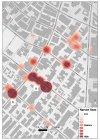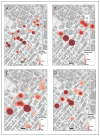An Exploration of Narcan as a Harm Reduction Strategy and User's Attitudes toward Law Enforcement Involvement in Overdose Cases
- PMID: 35328837
- PMCID: PMC8954857
- DOI: 10.3390/ijerph19063149
An Exploration of Narcan as a Harm Reduction Strategy and User's Attitudes toward Law Enforcement Involvement in Overdose Cases
Abstract
The street homeless, those who spend their nights either in shelters or unofficial camps, whether in tents on a street or in society's hidden spaces such as beneath an overpass, face multiple challenges beyond finding a safe place to sleep. Of further concern is how official actions can worsen these situations, through day-to-day activities or planned intervention strategies. In this paper we explore how a planned intervention may be negatively perceived-even as a form of "structural violence"-and may prevent Narcan (naloxone) use to stop an overdose related death in the Skid Row of Los Angeles. Data for this study consisted of a combination of Spatial Video Geonarratives (SVGs) and 325 incident reports from the Homeless Health Care Los Angeles Center for Harm Reduction (HHCLA-HRC) between November 2014 and December 2015. Chi-square and simple logistic regression models were used to examine the association between fear-of-arrest and other covariates of interest. Mapping results are presented with different sets of shapefiles created for (1) all Narcan uses, (2) all homeless, (3) all homeless with a worry about being arrested, (4) all Narcan uses where an ambulance attended, (5) and the same as 4 but also with police attendance. In the multivariable model, the estimated adjusted odds of fear-of-arrest is over three times higher among Narcan users ages 30-39 when compared to users under the age of 30. Analyzing the association of calling 9-1-1 on Narcan user demographics, socio-contextual characteristics, and overdose victim demographics, the crude estimated probability of calling 9-1-1 for Narcan users aged 50 and older is nearly three times higher when compared to Narcan users aged 19-29. Conclusion: Results suggest that the fear-of-arrest and calling 9-1-1 during an overdose is still a concern among Narcan users despite protective legislation and access to harm reduction resources.
Keywords: Narcan; harm reduction; homeless; naloxone; police; skid row; spatial video geonarratives.
Conflict of interest statement
The authors declare no conflict of interest.
Figures


Similar articles
-
Pennsylvania law enforcement use of Narcan.Am J Emerg Med. 2020 Sep;38(9):1944-1946. doi: 10.1016/j.ajem.2020.01.051. Epub 2020 Jan 28. Am J Emerg Med. 2020. PMID: 32057531 No abstract available.
-
Narcan and Narcan't: Implementation factors influencing police officer use of Narcan.Soc Sci Med. 2021 Feb;270:113669. doi: 10.1016/j.socscimed.2021.113669. Epub 2021 Jan 2. Soc Sci Med. 2021. PMID: 33445119
-
Law enforcement attitudes toward overdose prevention and response.Drug Alcohol Depend. 2013 Dec 1;133(2):677-84. doi: 10.1016/j.drugalcdep.2013.08.018. Epub 2013 Sep 2. Drug Alcohol Depend. 2013. PMID: 24051061 Free PMC article.
-
Twenty years of take-home naloxone for the prevention of overdose deaths from heroin and other opioids-Conception and maturation.Drug Alcohol Depend. 2017 Sep 1;178:176-187. doi: 10.1016/j.drugalcdep.2017.05.001. Epub 2017 May 25. Drug Alcohol Depend. 2017. PMID: 28654870 Review.
-
Narcan use in the endoscopy lab: an important component of patient safety.Gastroenterol Nurs. 2004 Jan-Feb;27(1):20-1. doi: 10.1097/00001610-200401000-00005. Gastroenterol Nurs. 2004. PMID: 15075960 Review.
Cited by
-
Police Use of Discretion in Encounters with People with Opioid Use Disorder: a Study of Illinois Police Officers.J Police Crim Psychol. 2024 Mar;39(1):141-156. doi: 10.1007/s11896-023-09628-9. Epub 2023 Nov 20. J Police Crim Psychol. 2024. PMID: 38617402 Free PMC article.
-
"There's No Heroin Around Anymore. It's All Fentanyl." Adaptation of an Opioid Overdose Prevention Counseling Approach to Address Fentanyl Overdose: Formative Study.JMIR Form Res. 2022 Sep 7;6(9):e37483. doi: 10.2196/37483. JMIR Form Res. 2022. PMID: 36069781 Free PMC article.
-
Police Stigma toward People with Opioid Use Disorder: A Study of Illinois Officers.Subst Use Misuse. 2023;58(12):1493-1504. doi: 10.1080/10826084.2023.2227698. Epub 2023 Jun 26. Subst Use Misuse. 2023. PMID: 37365862 Free PMC article.
-
A novel naloxone distribution intervention among persons experiencing unsheltered homelessness: acceptability of naloxone training and distribution during an annual point-in-time count.Harm Reduct J. 2025 Jun 9;22(1):102. doi: 10.1186/s12954-025-01250-8. Harm Reduct J. 2025. PMID: 40490800 Free PMC article.
-
When Unstructured Big Text Corpus Meets Text Network Analysis: Social Reality Conceptualization and Visualization Graph of Big Interview Data of Heavy Drug Addicts of Skid Row.Healthcare (Basel). 2023 Aug 31;11(17):2439. doi: 10.3390/healthcare11172439. Healthcare (Basel). 2023. PMID: 37685473 Free PMC article.
References
-
- Friedman S.R., de Jong W., Rossi D., Touzé G., Rockwell R., Des Jarlais D.C., Elovich R. Harm reduction theory: Users’ culture, micro-social indigenous harm reduction, and the self-organization and outside-organizing of users’ groups. Int. J. Drug Policy. 2007;18:107–117. doi: 10.1016/j.drugpo.2006.11.006. - DOI - PMC - PubMed
-
- Vuong Q.-H., Le T.-T., La V.-P., Nguyen H.T.T., Ho M.-T., Van Khuc Q., Nguyen M.-H. Covid-19 vaccines production and societal immunization under the serendipity-mindsponge-3D knowledge management theory and conceptual framework. Humanit. Soc. Sci. Commun. 2022;9:1–12. doi: 10.1057/s41599-022-01034-6. - DOI
MeSH terms
Substances
LinkOut - more resources
Full Text Sources

